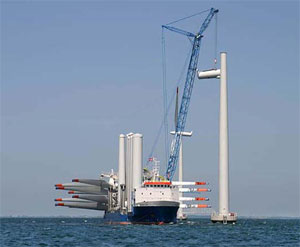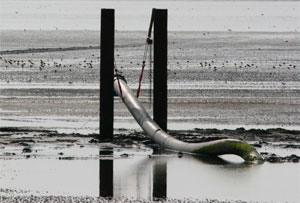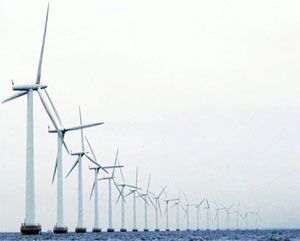A critical time for offshore wind
on
A critical time for offshore wind
The prospects of offshore wind power in northern Europe depend on two key factors: the ability of industry to reduce costs significantly and the willingness of governments to provide strong political backing. That was the main conclusion to come out of a conference about the future of offshore wind power in Northwestern Europe, held last week at the Clingendael International Energy Programme (CIEP), a prestigious energy think tank in the Netherlands. As Pieter Tavenier, Director Offshore of Dutch utility Eneco, trenchantly put it: ‘Offshore wind will boom or bust in the next decade.’
 |
|
A ship delivering propellers at the construction site at Horns Rev II, located in the North Sea. |
Interesting pointers
But this is still a big “if”. In January 2010 only some 2,000 MW of offshore wind capacity had been built, with some 3,500 MW under construction. This is just one-tenth of what is needed – in less than ten years’ time. So what would be needed to make North Western Europe’s offshore wind ambitions come true? And what will it all cost? These are the questions industry and governments currently grapple with.
As to costs, in the Netherlands a high-level, goverment-commissioned Task Force (called “Windenergie op zee” or “Wind energy at sea”) published a report on 21 May which provided some interesting pointers. The Task Force concluded that government support schemes for offshore wind in the UK, Germany, Belgium and the Netherlands are roughly the same at this moment. For a fictitious 4,800 MW
| The bill for the dream of 50,000 MW offshore wind power in North Western Europe may thus be expected to reach €200 billion in all – at least, if current support schemes are continued |
 |
| Cable required for power connection |
What industry needs to do, said Tavenier, is to aim for ‘subsidy independency’. In other words: bring costs down sharply – preferably to about €100 per MWh. How? In one word, by ‘industrialisation’. The major problem for the offshore wind industry is that there has been little progress in technology, Tavenier pointed out. ‘Around 15 utilities are active in the market, and everybody is gaining experience from their own one-off projects. What is lacking is standardisation.’
The industry, said Tavenier, must develop dedicated offshore turbines of at least 6 MW (twice as much as the current turbines), seek ‘integral system solutions’ rather than just ‘optimal components’, enter into long-term joint engineering projects with partners, and achieve economies of scale by constructing long-term trains over various sites and maximising the utilisation of vessels and assembly lines. ‘A project in 2015-2020 should be in a completely different league than today’, proclaimed the Eneco man. ‘It should have a minimum capacity of 5,000 MW, be spread out over multiple sites and constructed over a long period, based on a long-term supply chain with a dedicated assembly line and dedicated vessels.’
Tavenier is not the only one to realise that an industry-wide effort is needed to bring down costs. In the Netherlands, ten companies and research institutions joined forces in January of this year, in an ‘Innovation Program’ to ‘reduce costs and risks of far-offshore wind energy’. The participants in this so-called FLOW (Far and Large Offshore Wind Innovation) programme are drawn from the entire value chain. They include power companies (RWE and Eneco), grid operator Tennet, offshore engineering companies Ballast Nedam and Van Oord, vessel and equipment company IHC Merwede, wind turbine manufacturers 2-B Energy and Darwin and research institutions ECN (Energy Research Centre of the Netherlands) and the Technical University Delft. Martin Weissmann, Senior Developer of RWE-Essent, who represented FLOW at the conference, said he had a ‘positive message’ for the audience. ‘Developing far offshore wind is a huge challenge, but we have a clear idea how to tackle it. There is nothing to be afraid about.’
According to Weissmann, who envisions 35,000 MW of offshore wind capacity being built in Europe in 2020, it is possible to increase output through intelligent operation and maintenance (which would increase availability) and better design of components. He also believes it is possible to reduce costs through ‘cheaper components’ and ‘cheaper operation and maintenance’ and to reduce risks by better modelling of weather conditions and developing unproven technology. FLOW hopes to get the first projects started this year, especially in R&D, and will organise a conference for parties interested to join the consortium. Tavenier noted that the basis for FLOW is still small and that it would be better for the sector if more and larger stakeholders were included.
 |
| Wind park off the coast of Denmark. |
Certainly the political will to support offshore wind is not lacking. In fact, at the end of last year, nine ministers from nine countries bordering the “North Seas” (i.e. the North Sea, the Irish Sea and the Baltic Sea) signed a declaration called the North Seas Offshore Grid Initiative (NSOGI). They are Belgium, which took the initiative, Denmark, France, Germany, Ireland, the Netherlands, Sweden, the UK and (for some reason) Luxembourg. Later Norway signed on as the 10th country.
This Initiative, said Sue Harrison, Head of European Energy Markets at the UK Department of Energy and Climate Change (DECC), who spoke at the conference on behalf of all ten governments, is meant to be a ‘recognition of the crucial role to be played by offshore wind energy for the EU’s 2020 targets and for longer-term policy objectives’.
Harrison stressed that NSOGI is not meant to replace but to complement existing initatives, for example from the EU. In 2006 the European Commission adopted the TEN-E guidelines (Transeuropean Energy Networks), listing a number of cross-border gas and electricity infrastructure projects which are given high priority. This list includes grid connections for offshore wind power in Northern Europe. Georg Wilhelm Adamowitsch was appointed “European Coordinator” for the offshore wind connections in the Baltic and North Seas. Adamowitsch produced his second annual report in December 2009.
Go for the boom
Later this year, the European Commission will publish its long-awaited Infrastructure Package, which will be ‘a cornerstone of the wider European energy policy’ and will no doubt include a policy proposal on the offshore wind connections. In addition, ENTSO-E (the organisation of the Electricity Transmission System Operators), has formed an “offshore system development group” that is studying how best to integrate the expected offshore wind parks into the existing grid.
What NSOGI will try to add to these initiatives, said Harrison, is ‘to develop a long term political vision’ and ‘to provide political certainty for developers and suppliers to boost investor confidence’. In the Declaration of the NSOGI it is said that its objectives are ‘to identify national ambitions and shortcomings, to facilitate a coordinated infrastructure development, to achieve a compatible political and regulatory basis, and to foster a joint commitment of all relevant stakeholders to tackle all barriers’. The first steps will be to hold ‘a High Level meeting’ in the second half of 2010 in order to agree on a ‘strategic working plan’ by means of a ‘memorandum of understanding’.
Harrison said that the NSOGI is still examining where the political initiative can add real value. One clear area where governments can make a difference is to remove legal and regulatory barriers which may impede grid developments. NSOGI will also undertake a cost-benefit analysis of various possible grid configurations. Harmonisation of subsidy schemes is not on the cards for now. The countries participating do not see the need for it, said Harrison.
For the moment, then, both industry and governments have a tough job ahead of them if they are to realise Northern Europe’s offshore wind power dreams. And it is not certain yet whether they are up to their job. As Tavenier succintly put it: ‘It will be boom or bust for offshore wind in the next decade.’ But he added a positive note: ‘I think we can do it. We will be able to bring down costs. At Eneco we will go for the boom.’


Discussion (0 comments)